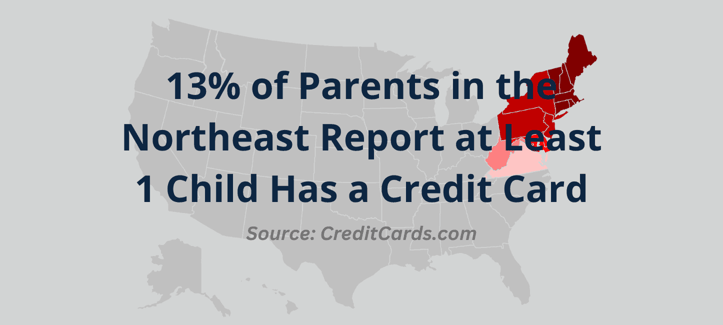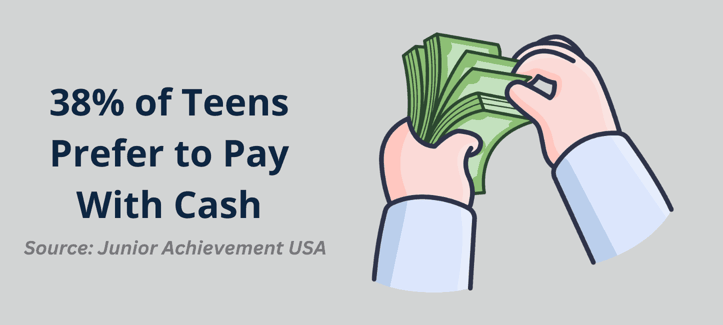
Opinions expressed here are ours alone, and are not provided, endorsed, or approved by any issuer. Our articles follow strict editorial guidelines and are updated regularly.
Parents may be skeptical about giving their teens a credit card for fear of the debt they may rack up. But there are more financial benefits than downsides to consider.
With the right guidance, a young adult who has the opportunity to use a credit card in high school and college can learn how to manage spending and start building healthy money habits that lead to greater financial success later in life. Not to mention, a credit card allows teenagers to establish and build credit, which will be essential when it comes time to rent an apartment, buy a car, or open a utility account in their own name.
Whether you’re ready to give your kid a credit card, here are 11 surprising stats about teens and credit cards all parents need to know.
-
Navigate This Article:
1. 1 in 6 Kids Has a Credit Card in Their Name
Teens with credit cards aren’t very common, as only 1 in 6 minors are reported to have a card in their own name.1 While there are a variety of factors at play, parents should consider the upside to teaching their teens how to use a credit card wisely before their child moves out on their own when they’re more likely to make poor decisions and rack up debt.
2. 1 in 4 Parents Admit Unauthorized Card Charges Cause Family Squabbles
Money is often a source of friction in many relationships, even between parent and child. In fact, 1 in 4 parents said they have argued about money with their kids, citing credit card use without parental permission as the second most common disagreement.1
3. Teens Rack Up an Average of $500 in Secret Credit Card Purchases
It’s easy for teens to make purchases on a credit card without parental permission thanks to how payment info is stored in online retail accounts and mobile applications, something more families are dealing with these days. Forty-six percent of parents surveyed said they caught their children making secret purchases with their credit or debit cards which racked up an average balance of over $500.1

Setting strict boundaries and teaching teens how to use credit cards wisely is essential to avoiding messy spending situations like this in the future.
4. Only 8% of Teens Have a Credit Card, But 53% Have a Cellphone
Cellphones are way more important to teens than credit cards. Only 8% of US parents with children under 18 said they have at least one child with a credit card, on average.2 In comparison, 53% of these same families said they have a child with their own mobile device.
5. 13% of Parents Who Make $80,000+/Year Have at Least 1 Kid With a Credit Card
Children under 18 are more likely to have access to a credit card if mom and dad earn a high income compared to peers with parents who make less. Thirteen percent of surveyed parents who earn over $80,000 said they have at least one child at home with a credit card.2
In comparison, just 9% of parents who make between $40,000 to $80,000 said they have a kid at home with a credit card, and that number drops to less than 5% among parents who make less than $40,000.
6. Teens in the Northeast are More Likely to Use Credit
Where you live in the US doesn’t just impact how much you pay for groceries or housing, it also impacts your child’s financial habits. Credit card use among teens varies significantly by region and class.

Specifically, 13% of parents living in the Northeast report that at least one of their underage children has a credit card.2 That’s compared to just 8% of families living in the South and the West, and just 5% of Midwest parents surveyed who said their minor children had a credit card.
7. 48% of Parents Second-Guess Allowing The Use of Credit
Many parents struggle with the decision to give their teens access to a credit card. In fact, 48% of parents have second-guessed their decision to allow their kids to use their credit cards.1
But with proper guidance and a clear set of rules on spending limits, parents can help teens develop healthy credit card habits that can lead to better financial outcomes later in life.
8. Dads Are More Likely to Allow Credit Purchases Than Moms
Six in 10 parents said they’ve given their children permission to use their credit or debit card to make an online purchase, with fathers slightly more likely to do so than mothers.1 When it comes to adding a teen as an authorized user on a credit card account, the same survey found that 31% of men were more likely to do so than women.
9. 38% of Teens Said Cash Was Their Preferred Payment Method
Young adults may be addicted to tech, but not when it comes to making purchases. Thirty-eight percent of teen survey respondents said cash was their preferred payment method.3 Meanwhile, only 2% of those surveyed said they would rather use a fintech app like Zelle, Venmo, or ApplePay to complete a transaction.

Most teens (71%) said they receive a gift of money from parents or caregivers in the form of cash. That’s down to 57% today.
The opportunity to use those dollars to pay off a credit card purchase, build credit, and establish healthy spending habits is lost here.
10. There Was a 6% Drop in Credit Card Use Among Teens Between 2019 and 2022
While cash still rules, US teens are quick to adopt fintech apps and ignore other traditional payment methods like credit cards. Over the course of a three-year period, from 2019 to 2022, there was a 6% drop in credit card use among teens as a result.3
11. 50% of Gen Z Have a Prime Credit Score
Gen Z is a very credit-savvy generation, even more so than some of their older cohorts, according to the Global Gen Z Report from TransUnion. In fact, the report found that 50% of this age group (between 18 to 24) has a prime or above credit score surpassing millennials when they were the same age.4
Things to Consider Regarding Teen Credit Card Use
Getting a teen a credit card isn’t difficult, but it’s important to understand the laws established to protect minors first. Specifically, the 2009 Credit Card Accountability Responsibility and Disclosure (CARD) Act bans credit card companies from authorizing anyone under the age of 21 to open a new account without an adult cosigner or proof of sufficient income that would be needed to repay debt.5
Few credit card companies issue credit cards to teens under the age of 18, even if they’re able to provide these two requirements. For many, the best approach to get your teen a credit card is to add them as a secondary, authorized user on your account.
A secondary or authorized user can use the card to make purchases and will benefit from the primary account holder’s credit score. Authorized users are not responsible for payment of balances by the credit card company, so it’s imperative that parents monitor purchases closely and set strict rules about how their teen can use the card and how much of the bill they are required to pay.
Data Sources:
1 2022 LendingTree Kids and Credit Cards Survey
2 2019 CreditCards.com Kids and Credit Cards Poll
3 2022 JA Teens & Personal Finance Survey
4 TransUnion Global Gen Z Report
5 FTC.gov Credit Card Accountability Responsibility and Disclosure Act of 2009, 123 STAT. 1748




![[current_year] Credit Card Debt Statistics (Average U.S. Debt) [current_year] Credit Card Debt Statistics (Average U.S. Debt)](https://www.cardrates.com/images/uploads/2018/04/shutterstock_243114739-edit.jpg?width=158&height=120&fit=crop)
![15 Disturbing Credit Card Fraud Statistics ([current_year]) 15 Disturbing Credit Card Fraud Statistics ([current_year])](https://www.cardrates.com/images/uploads/2020/08/shutterstock_576998230.jpg?width=158&height=120&fit=crop)
![21 Startling Credit Card Data Breach Statistics ([current_year]) 21 Startling Credit Card Data Breach Statistics ([current_year])](https://www.cardrates.com/images/uploads/2023/10/Credit-Card-Data-Breach-Statistics.jpg?width=158&height=120&fit=crop)
![18 Revealing Credit Card Ownership Statistics ([current_year]) 18 Revealing Credit Card Ownership Statistics ([current_year])](https://www.cardrates.com/images/uploads/2023/11/Revealing-Credit-Card-Ownership-Statistics.jpg?width=158&height=120&fit=crop)
![25 Shocking Credit Card Processing Statistics ([current_year]) 25 Shocking Credit Card Processing Statistics ([current_year])](https://www.cardrates.com/images/uploads/2023/11/Credit-Card-Processing-Statistics.jpg?width=158&height=120&fit=crop)
![25 Fascinating Credit Card vs. Cash Spending Statistics ([current_year]) 25 Fascinating Credit Card vs. Cash Spending Statistics ([current_year])](https://www.cardrates.com/images/uploads/2023/11/Fascinating-Credit-Card-vs.-Cash-Spending-Statistics.jpg?width=158&height=120&fit=crop)